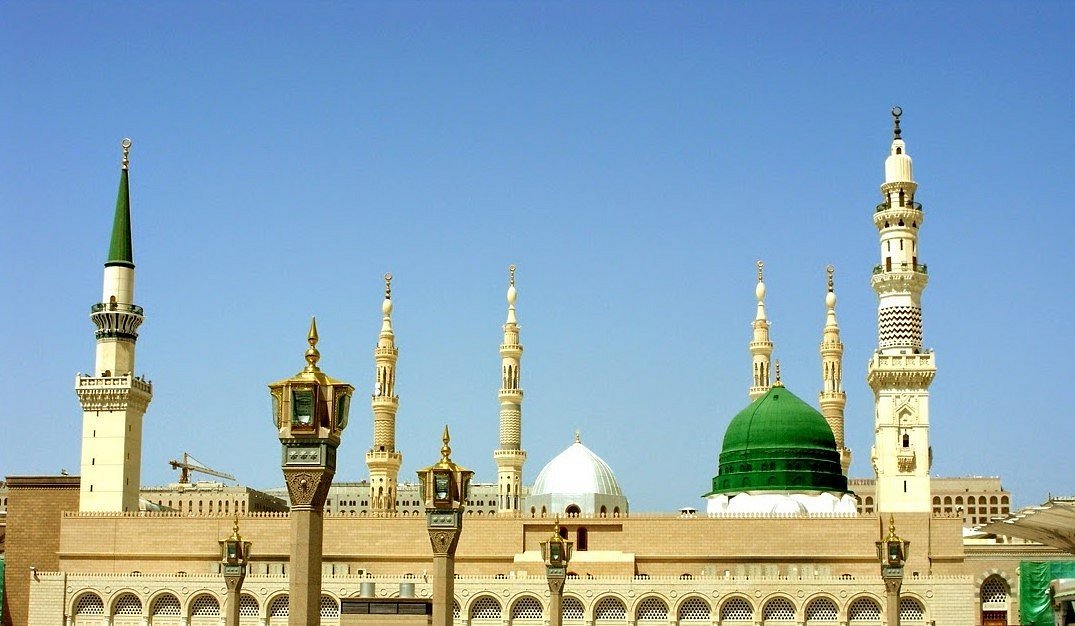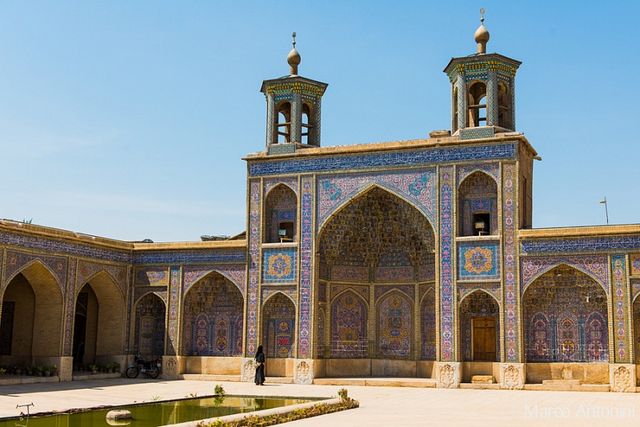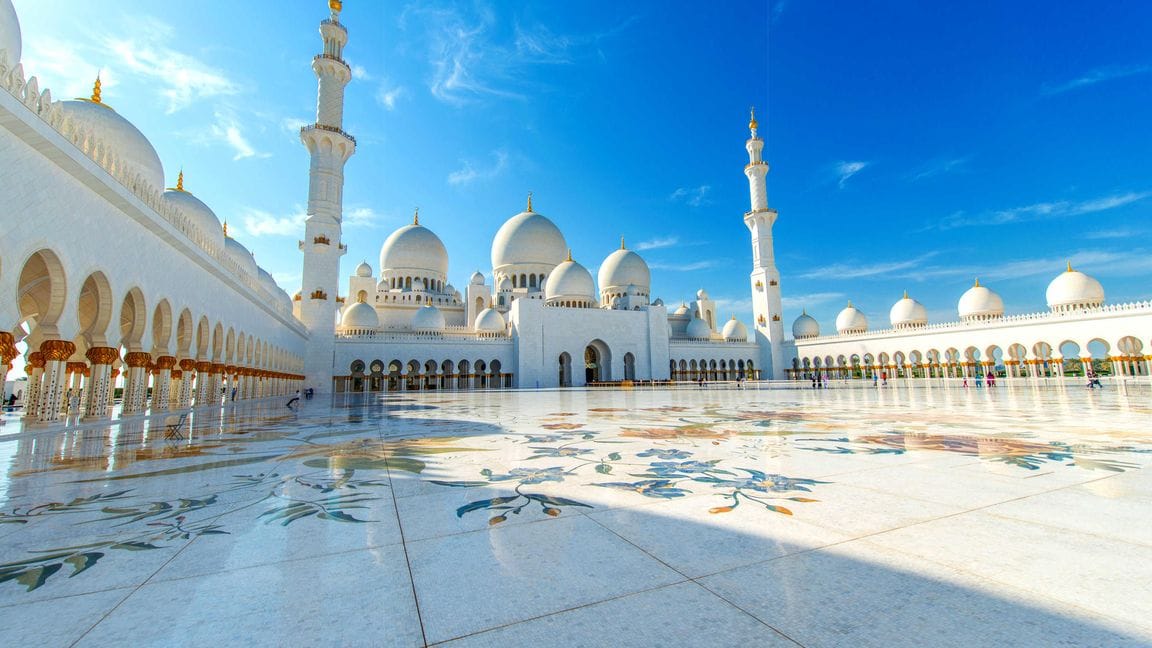The deep philosophical meaning of the world order and human destiny in this diversify and fast-paced world is embedded in the architecture and decoration of oriental mosques. As it is known, a mosque is a common place of the acts of worshiping for all Muslims of the world, no matter which confession they belong to, it is a special holy place of communion with God.
Muslim percepts and teachings intertwined in lace into the elements of the mosques, pilgrims from all over the world wish to touch to sacred objects of their religion, travelling thousands of kilometers.
Let’s consider the most beautiful and unique mosques of the world and their construction peculiarities of their decoration:
Al-Haram Mosque, Mecca (Saudi Arabia) is the main unique mosque of the Muslim world. Erected in 638, it has been reconstructed and rebuilt several times over time, its area is 400800 m2.

Photo: medinaschool.org
In its structure organically combined ancient oriental motifs with the newest modern architecture achievements (there are 7 escalators and air-conditioners). Marble columns are the decoration of the inner facing, and majestic 9 minarets soars their spires high to the heaven (height – 95 meters). A notable feature of the Forbidden Kaaba Mosque is the main shrine of Muslims around the world.
Al-Nabawi Mosque, Medina (Saudi Arabia) – according to handwritten sources, it was built during the lifetime of the Prophet Muhammad. The second mosque by the importance of the Muslim world is the place of pilgrimage not only the adepts of Islam, but also for numerous tourists. In the center of the mosque is a Green Dome, where the grave of the prophet is located. The mosque has 10 minarets (height – 105 m), and is able to accommodate up to 500 thousand believers.

Photo: ummet.kz
Sheikh Zayed Mosque, Abu Dhabi - the Islamic temple is built of marble and combines two architectural styles: Persian and Arabic. The arches of the courtyard and the main entrance are decorated with carvings and Persian paintings.


Photo: planetofhotels.com
One of the largest chandeliers in the world (10 m in diameter, 15 m in height, weight 12 tons), consisting of gold leaf and crystals, rises above the magnificent carpet, lined inside. In front of the mihrab – there are double columns and arches, creating the impression of the infinity of the hall. The exterior decoration of the mosque is complemented by a delicate yellowish and blue illumination, reflected in the cool pools. 3,500 workers from 38 companies of the world worked on the implementation of the grandiose project; the construction was carried out for 12 years.
Sultan Omar Ali Saifuddin Mosque, Brunei – The Royal Mosque harmoniously fits into an artificial lagoon on the banks of the river, with luxurious green gardens and unique fountains spread around it. It is a striking example of modern Islamic architecture. The height of the main dome is 52 meters, with a real gold coating.
Photo: paks.ru
The prayer hall made of mosaic glass, carved arches and marble columns, impresses with its splendor. The main pride of the Royal Mosque is the minaret, made in the Renesas style and traditions of the Italian architecture. The interior is sinking in luxury: stained glass windows and chandeliers were brought from Britain, luxurious carpets were woven in Belgium and Saudi Arabia, a unique mosaic of 3.5 million pieces was brought from Venice.
The Blue Mosque, Istanbul – one of the oldest and most picturesque mosques in the world, in the architecture of which the Islamic and Byzantine architectonics have merged. Surahs from the Koran and words spoken by the Prophet Muhammad make the basis of the dome paintings. The prayer niche is a mihrab, carved from a single piece of marble; and the Muslim shrine located in it is a black stone, brought by pilgrims from Mecca.


Photo: tournavigator.pro
There are 206 windows and a lot of light in the mosque; the columns and arches painted with patterns in accordance with the Islamic pictorial art and calligraphy canons and arches impress with their beauty. The mosque is located in the historical part of Istanbul and fits perfectly into its architecture.
Nasir al-Mulk Mosque (Nasir al-Mulk), Iran – “Pink Mosque” - is a bright landmark of global significance. The mosque was built in the XIX century (1876-1888) by order of one of the lords of the Qajar dynasty. The stunningly beautiful structure was designed by Muhammad Hassan-e-Memar and Muhammad Reza Kashi Paz-i-Shirazi. Its entrance is decorated with mosaics and verses from the Koran, and stained-glass windows are used as the main decoration.

Photo: eurasia.press
The abundance of stained-glass windows picturing a huge number of roses makes this mosque one-of-a-kind. This circumstance breaks out of the generally accepted rules and canons in the decoration of Muslim mosques.


Photo: eurasia.press
The area of the interior space of Nasir al-Mulk is 2.9 thousand sq.km., a special admiration causes the Pearl Arch, 7 columns and 2 minarets. Kaleidoscopic technique of execution (triangles, rhombuses, ornaments) gives incredible color shimmers during the passage of sunlight. The floor tiles of seven colors and the amazing play of light reflected in it served to give the mosque many names: “Rainbow Mosque”, “Pink Mosque”, “Mosque of Flowers”. In 1979 the Iranian authorities turned the Mosque into Museum and took it out of a number of places of worship.
Faisal Mosque, Islamabad is the fourth largest mosque in the world and the largest in Southeast and South Asia. Turkish architect Vidat Dalokai – the author of the project, instead of traditional domes, created a structure resembling a Bedouin tent. He won the competition, where 43 proposals from 17 countries were submitted.

Photo: planetofhotels.com
Four minarets (height 90m) surround the Main Hall, inside of which the walls are covered with marble, mosaic and calligraphy of the Pakistani Artist Sadegain and amazing chandeliers in Turkish style. There are two prayer area for 10 000 and 24 000 thousand believers, another 40,000 can be accommodated in the courtyard.
It is symbolic that the synthesis of ancient national traditions and modern design technology, elaborately combined in numerous Eastern mosques, contributed to the fact that Islamic culture become the embodiment of the brightest achievements of artistic and architectural styles.
Source: bigpicture.ru; parstoday.com; most-beauty.ru; novate.ru
Also read:


